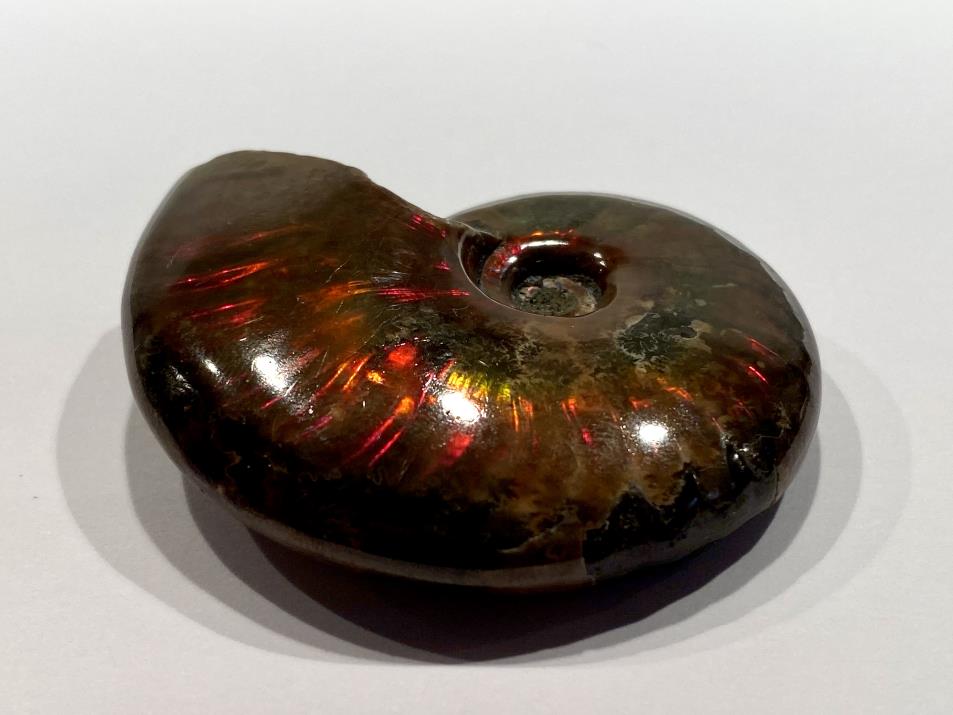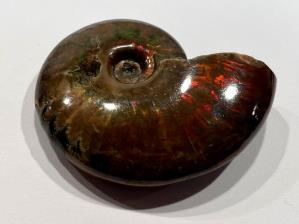FREE SHIPPING
On UK Mainland orders over £30
Red Iridescent Ammonite 5.2cm
Cleoniceras Red Iridescent Ammonite fossils for sale from Madagascar.
This gorgeous Red Iridescent Ammonite, measuring 5.2cm wide at its widest point, is a very well preserved fossil from Madagascar and exhibits a dazzling red iridescent colour with stunning flashes of green and intricate fern-like suture patterns.
What Are Ammonites?
Ammonites are a group of extinct molluscs which somewhat resembled a shelled squid when they were alive.
These ancient sea creatures had tentacles like the modern octopus, and spiral shells like Nautilus creatures.
They first appeared on the fossil record 240 million years ago, in the Triassic Period, and died out 65 million years ago with the dinosaurs during the Cretaceous-Tertiary Mass Extinction Event.
The fossilised remains of these sea creatures are perhaps the most popular fossils on the market today.
This particular ammonite is a member of the Cleoniceras species of ammonites.
How Old Are Ammonites?
This ammonite dates back to the Cretaceous Period, meaning it is 120 million years old.
Where Do You Find Iridescent Ammonites?
This ammonite was originally found in the jungles of Mahajanga on the North West Coast of Madagascar.
Madagascar is famed for its riches of fossils and natural diversity, and a wide variety of fossils and crystals can be found there.
Gem quality iridescent ammonite shells are most famously found in Canada, where they are called "Ammolite".
Ammolite is the official gemstone of Alberta.
How The Ammonites Became Fossils
When an ammonite creature died, it became fossilised in the process as follows:
- Ammonite bodies sunk into the seabed sediment, and over time the many sediment layers hardened into rock, preserving the fossils within.
- Throughout this process, bacteria decomposed the ammonite bodies.
- This decomposition affected redox conditions in the marine environment, leading to dissolved minerals such as carbonates and phosphates becoming less soluble in water.
- The minerals were precipitated out of the water, and enveloped the ammonite in a solid concretion, which ensured the fossil and its nacreous shell was preserved for thousands of millennia.
- Some minerals seeped into the ammonite remains, leading to mineral replacements and ornately coloured interiors.
- The rock covering the ammonite fossils was then either naturally eroded, or excavated by humans, to expose the fossils.
What Are Iridescent Ammonites Made Of?
The iridescent shell of an ammonite is formed from the mineral Aragonite, a component of Nacre (also known as Mother of Pearl).
This nacreous shell, with its rainbow colours, is what is turned into gemstones such as Ammolite.
Gem ammonites such as this red iridescent ammonite are called biogenic gemstones (the only other gems of this type are pearl and amber) because they are formed from the fossilised organic material of once living creatures.
Fossilised ammonites are also full of minerals such as Calcite and Pyrite, as well as trace elements such as copper.
The composition of each ammonite can vary greatly due to the different minerals that seeped into it as it decomposed and fossilised.
Why Are Ammonites Iridescent?
The distinctive colour, lustre, and opal-like effect of iridescent ammonites is caused by their Aragonite shells.
Inside the shell, there are many stacked layers of Aragonite which light must travel through when it is shone on the shell.
As light bounces back through the layers of Aragonite, a rainbow spectrum of colour can be observed due to the interplay of light travelling through the layers.
Thick layers of Aragonite typically leads to shades of red being observed, such as in this red iridescent ammonite, whilst thinner layers lead to shimmering greens, which can also sometimes be observed in red iridescent ammonites.
The thinnest layers of Aragonite lead to rare blue and violet hues being observed.
Flashing Iridescent Colours Of Ammonites
As you move an iridescent ammonite in the presence of light, one can observe the colours moving, changing, and flashing in what is known as chromatic shift.
Other Names For Iridescent Ammonites
Due to their fiery hues, these red iridescent ammonites are often referred to as fire ammonites, although they are also sometimes called opalescent ammonites in reference to their opal-like appearance.
Iridescent Ammonites Myth And Legend
Greek myth gifted the fossils with their famous name; the coiled shell of this ancient marine mollusc resembles the horns of rams, therefore its remains were classified as ‘ammonites’, after the Greek ram god Ammon.
in India, the fossils are still referred to as ‘Shaligrams’ (or ‘Saligrams’) and worshipped as representations of the Hindu God Vishnu.
To many Hindus these stones are sacred, for they have the power to expel bad karma and cleanse people of sin before their death, enabling them to enter the afterlife.
The Blackfoot Tribe of North America referred to iridescent ammonites (later known as ammolite) as 'Iniskim', or buffalo stones.
Buffalo Stones were thus named because the ammonite was believed to be a good luck talisman which ensured a fruitful buffalo hunt.
The tribe also revered this gem like fossil for its purported medicinal powers.
Iridescent Ammonites Metaphysical Properties
Iridescent ammonites, especially those with gem-like shells, are believed to have powerful metaphysical properties.
These fossils are believed to bring prosperity, wisdom, and knowledge to their user.
Gem ammonites are said to have a detoxifying energy that develops focus and a sense of balance.
The red colours present in their iridescent flash signifies vitality, passion, and stimulation.
Iridescent Ammonites Chakras
Iridescent Ammonites are most associated with the Root Chakra due to their strong connection to the Earth as organic gemstones.
When used with this chakra, these stones offer protection, grounding, and stability.
For this reason, they can be used to help strengthen rocky relationships.
Iridescent Ammonites In Feng Shui
Metaphysically, Feng Shui masters highly recommend the use of ammonites in the study of their art, and as a way of gaining knowledge, wealth, and prosperity.
Some Feng Shui practitioners believe ammonites store all the knowledge in the universe, and strengthen people’s Qi (life force)
Sacred Geometry Of Ammonite Spirals
In sacred geometry, the spiral shape has powerful spiritual significance, and signifies growth and expansion.
As ammonite shells display distinctive spiral shapes, ammonites embody this spiritual meaning of growth too.
An ammonite shell is a perfect example of the sacred Golden Mean Spiral, a symbol of the infinite Fibonacci Sequence and the revered Golden Ratio.
As a result, ammonites are believed to be strongly symbolic of order and perfection in not just the natural world, but the entire universe.
How To Take Care Of Iridescent Ammonites
Measuring 4.5 to 5.5 on the Mohs scale, this stone is rather fragile and great care should be taken not to damage its delicate surface.
To clean the fossil, simply use water and dry it afterwards with a soft cloth.
Take care not to expose iridescent ammonites to heat, cold, or sunlight for too long, because these elements can cause the shell to crack and flake.
Iridescent Ammonites Collections
This stunning iridescent ammonite was specially selected for its quality, and was prepared in our workshop in the United Kingdom to enhance its high grade and polish.
With its gorgeous shimmering shell, it would make a perfect addition to any fossil collections, and a great choice for anyone looking for some high-quality fossil gifts.
Buy Red Iridescent Ammonites online now at Madagascan Direct.







